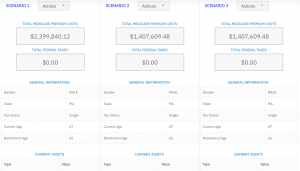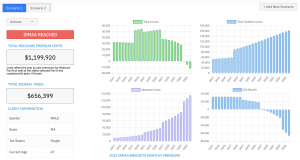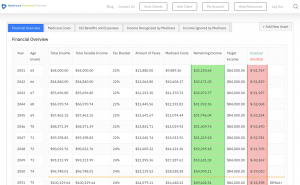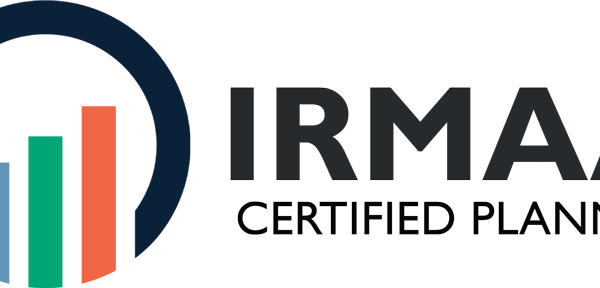Last year, I sat down for coffee with a friend who’d just retired. He leaned in close as we sipped our drinks, murmuring with a hint of bitterness, “I never expected this Medicare IRMAA to hit me so hard.” The IRMAA on my Medicare.” There it was – the sting of IRMAA income limits 2023. He thought his golden years were all set but didn’t account for how his nest egg would bump up against those pesky thresholds.
Now, you might be wondering about this financial curveball too. It’s like playing baseball where they switch out the ball mid-pitch—suddenly your swing has to change. Well, here’s the scoop: if your annual earnings climb over a certain line in the sand drawn by Uncle Sam, brace yourself; you could be paying more for that health care slice of retirement pie.
Let’s discuss how to best manage the potential charges associated with health care in retirement. I’ll share some savvy tips that could really save you a bundle on premiums. Think of it as your financial defense strategy—no spooky surprises here!
Understanding IRMAA Income Limits for 2023
Ever felt like you’re playing a high-stakes game of “The Price is Right” with your Medicare premiums? Well, if your income’s on the higher side, that’s exactly what it can feel like when IRMAA (Income-Related Monthly Adjustment Amount) steps into the ring. Let me break it down for you: If your modified adjusted gross income (MAGI) gets too pumped up and crosses certain thresholds, BAM. You’re hit with an extra charge on top of your standard premium.
What Constitutes Higher Income for IRMAA?
Gone are the days when ‘high-income’ meant yacht parties and caviar brunches. In the world of Medicare, ‘higher-income’ beneficiaries are those who have a MAGI above specific limits set by Uncle Sam—and trust me; these aren’t just billionaire problems. For 2023, if you’re flying solo and making more than $91k or rolling as a married couple over $182k annually—congrats—you’ve made it to higher-income status in the eyes of Medicare.
This means that while most folks pay the standard Part B plan premium each month along with their prescription drug coverage costs—because let’s face it—we all need our meds; some will get slapped with additional charges based on how high their incomes soar. It’s kinda like paying cover at a club nobody wants to be part of but everyone needs—the exclusive ‘IRMAA Club’ where membership fees definitely don’t come cheap.
Calculating Adjusted Gross Income vs. Modified Adjusted Gross Income
You might think AGI (Adjusted Gross Income) and MAGI (Modified Adjusted Gross Income) are siblings in tax-speak—they kind’a look alike but play very different roles when determining your dues for this not-so-fun club called IRMAA.
Your AGI includes all taxable dough raked in during the year minus certain deductions—it’s pretty much everything including wages, dividends, alimony received…you name it—if Uncle Sam can tax it before applying itemized or standard deductions—that’s AGI for ya. But here comes MAGI strutting into town—it takes that same figure then adds back some items such as non-taxable Social Security benefits and/or Medicare savings from retirement accounts among others things you thought were safe from taxation’s grasp.
The kicker? That number decides whether or not—and by how much—you’ll be shelling out extra cashola every month towards both Parts B & D because remember kids: today’s health care ain’t free.
Key Takeaway:
Feeling like a contestant in the Medicare game? Higher incomes mean higher premiums, thanks to IRMAA. If you’re single earning over $91k or married above $182k, prepare for extra charges on your Part B and D plans.
MAGI is the key player here; it’s AGI with some tax-exempt items added back. It determines if you’ll join the ‘IRMAA Club’—and how much that membership will cost.
How Is the Medicare IRMAA Calculated for 2023?
So, you’re sifting through your mail and there it is—a letter from the Social Security Administration. It’s about your Medicare premiums for 2023, and they’re talking about something called IRMAA. Before you start wondering if that’s a new health condition to worry about, let me break it down for you: IRMAA stands for Income-Related Monthly Adjustment Amount.
We all know Uncle Sam likes to keep things interesting with our finances, especially when we talk taxes and benefits. Here’s how he calculates this little puzzle: The SSA takes a peek at your tax return from two years back because apparently what you earned then is a great way to guess what you’ve got in your pockets now.
The Role of Tax Returns in Determining Your IRMAA
Your MAGI—or Modified Adjusted Gross Income—is like the VIP list that decides whether or not you’ll be paying extra on top of your standard Medicare Part B and Part D premiums. This includes some dollars most folks forget about—like non-taxed social security benefits, untaxed foreign income (for those lucky ducks with cash across borders), or even moolah from tax-exempt interest.
If after adding up all these bits and bobs together gets you over certain thresholds—which by the way change as often as fashion trends—you’ll have an additional charge known as an “IRMAA surcharge” tacked onto each month’s premium payment. It might feel like high school all over again—with higher-income brackets landing in their own exclusive club—but instead of popularity points, we’re counting dollars here.
Calculating Adjusted Gross Income vs. Modified Adjusted Gross Income
Moving on to AGI versus MAGI—it feels kinda like choosing between two almost identical paint swatches at first glance but stick with me. Your AGI includes everything but kitchen sink—and by ‘kitchen sink’ I mean deductions like student loan interest payments or tuition fees which can make it lower than total income.
MAGI then steps into spotlight saying “Hold my beer” while putting its party hat on—that means tossing some extras into mix such as non-taxable social security dough (yes.), IRA contributions playing hard-to-get are excluded though—they don’t count towards lowering that number when figuring out where ya stand with Mr.IRMAA. Check out CMS guidelines if doubts keep nagging ya.
- Breathe easy: By maintaining clean filters, you can ensure that your indoor air is free of pollutants and allergens. Regular upkeep not only enhances the atmosphere of your home, but also boosts the efficiency of your HVAC unit.
Key Takeaway:
IRMAA is all about your income from two years ago—think of it as a financial flashback that determines if you’ll pay more for Medicare Part B and D. Your tax return holds the key, where Uncle Sam looks at your MAGI to decide if you’re in for extra monthly charges.
MAGI’s the name of the game—it adds certain forgotten funds back into your AGI, like non-taxed social security or foreign income. Cross specific income thresholds and bam—you’ve got yourself an IRMAA surcharge on top of regular premiums.
Strategies to Manage or Reduce Your IRMAA Charges
You might feel like the Social Security Administration has got your number, especially when it comes to Medicare premiums. But don’t sweat it; there are legit ways to play this game smarter and potentially reduce those pesky income-related monthly adjustment amounts (IRMAA). So buckle up because we’re about to turn some financial tricks that could help you save on those premium surcharges.
Utilizing IRA Contributions to Adjust Your Income Level
Think of your IRA as a financial Swiss Army knife. Not only does it prepare you for retirement, but with some clever maneuvering, it can also influence what’s known in the medicare world as modified adjusted gross income (MAGI). And why should you care? Because MAGI is the big cheese that determines whether you’ll pay extra for Medicare Part B and prescription drug coverage under Part D through IRMAA charges.
If your annual income dances over certain thresholds—like doing the cha-cha right past “affordable” into “yikes.” territory—you’re going to see higher numbers on your bill. For singles, crossing $91,000 starts ringing bells at Uncle Sam’s office in 2023; married folks filing jointly hit that buzzer at $182,000. Suddenly finding yourself reaching for more than just aspirin after seeing those numbers?
Fear not. Making strategic contributions into an IRA might be one way to adjust downwards how much money counts towards these limits by reducing taxable income now—and potentially slicing away at future IRMAA surcharges faster than a ninja cuts pie charts.
Navigating Changes in Life Circumstances That Affect IRMAA
Sometimes life throws us curveballs—or entire bowling alleys worth of them—all at once. Big changes like retiring early or later than expected can mean different things for our wallets and health care costs alike.
Luckily, if such events change how thick our stacks of cash are compared against IRMAA brackets, we’ve got options better than calling ‘mayday’ from a sinking ship. The key here is knowing which life-changing events qualify so you can appeal faster than someone dodging raindrops during monsoon season.
Historical Trends in Medicare’s Income-Related Surcharges
The landscape of Medicare premiums isn’t static—it evolves like fashion trends but less fun. Over time high-income beneficiaries have seen shifts akin to tectonic plates moving beneath their feet regarding premium adjustments based on their incomes. Did anyone ever think reading about historical data could make pulses race? Maybe not—but understanding where we’ve been helps predict where these IRMAA (Income-Related Monthly Adjustment Amount) charges might head next, ensuring you’re better prepared for future changes.
Key Takeaway:
Feel like Medicare’s IRMAA is picking your pocket? Use an IRA to lower your MAGI and you might just sidestep those higher premiums. Big life changes on the horizon? Know the rules so you can appeal IRMAA faster than lightning.
Remember, as income thresholds shift, staying clued into historical trends can keep surprises at bay and money in your wallet.
Navigating Changes in Life Circumstances That Affect IRMAA
Life is full of curveballs, and sometimes they can send your Medicare costs flying. The Income-Related Monthly Adjustment Amount (IRMAA) isn’t set in stone—it changes as you do. Whether it’s retirement knocking on your door or an unexpected shift in income, understanding how these life-changing events impact your IRMAA determination is key to keeping a few more dollars in your pocket.
What Triggers a New Look at Your IRMAA?
Say goodbye to the days when one big financial change meant waiting forever for relief from higher Medicare Part B and Part D premiums. Now, if certain major events hit you like a ton of bricks, the Social Security Administration may just give you some breathing room by recalculating those pesky surcharges. But what counts? Well, think marriage bells ringing or ending; work waving buh-bye with retirement; or even loss turning life upside down.
The appeal process doesn’t have to be daunting—armed with proof and persistence, presenting your case could lead to lower monthly premiums faster than you can say “bureaucracy.” And remember that golden nugget from two years back—the tax return that decided this year’s charges? It might need another glance because things have definitely changed since then.
Cracking the Code: How To Appeal
If wrangling paperwork was an Olympic sport, appealing an IRMAA decision would take gold. Start by grabbing Form SSA-44 directly from Social Security’s website. Then sprint through gathering documentation like there’s no tomorrow because proving that ‘life-altering event’ is not for the faint-hearted.
You’ll want evidence tighter than Fort Knox showing exactly how much less green is lining your pockets now compared to before—whether it’s due to saying farewell at the office party or switching rings after altering relationship statuses. After all that hard work filing papers—if Lady Luck smiles upon you—you’ll get notice quicker than ever about whether Uncle Sam agrees it’s time for a smaller slice of your pie chart going towards Medicare premiums.
A Few More Tricks Up Your Sleeve
Besides tying up loose ends with appeals when life hits hard, there are clever ways high-income beneficiaries can keep their Modified Adjusted Gross Income (MAGI) under wraps so as not to trigger higher payments unnecessarily—because who wants that? One such magic trick involves funneling funds into IRA contributions strategically throughout the year which might make enough difference on paper come tax season—and ultimately affect future determinations concerning drug coverage premium adjustments too.
Mindful maneuvering around MAGI also means getting a solid understanding of how it affects your taxes. Dive into the specifics, and you’ll be better equipped to plan your finances smartly.
Key Takeaway:
Life changes like retirement or income shifts can impact your Medicare costs. Act fast and show solid proof if you need to appeal an IRMAA decision—quicker results might just be on your side.
Clever planning, like strategic IRA contributions, could keep your income in check for Medicare purposes. Know how it plays with taxes to save smartly.
Historical Trends in Medicare’s Income-Related Surcharges
Medicare, like a fine wine, has changed over the years. But instead of getting fruitier or more robust, it’s gotten pricier for folks with heavier wallets. If you’ve been successful enough to enjoy a higher income, Uncle Sam gives you a not-so-sweet bonus: IRMAA surcharges on your Medicare premiums.
We’re talking about those extra dollars tacked onto Parts B and D if your modified adjusted gross income (MAGI) gets too high. It feels like just yesterday when these charges were introduced; but in reality, we’ve seen this trend evolve significantly.
The Social Security Administration decides who needs to cough up these extra bucks by peeking at tax returns from two years back. So yes, what you earned then affects what you pay now—kind of like how eating that last slice of pizza affects tomorrow’s waistline measurement.
What Constitutes Higher Income for IRMAA?
In 2023 terms, being “higher-income” isn’t just having enough dough to splurge on brand-name cereal rather than the store-brand stuff—it means crossing specific MAGI thresholds set by our pals at CMS. You cross that line? Bam. You get hit with an IRMAA surcharge faster than you can say “modified adjusted.” The bar keeps moving though; one year might have had lower limits before they got hiked up again due to changes in urban consumers’ consumer price index—or as I call it, life’s cost-of-living cheat code.
The latest guidelines, hot off the press from CMS themselves tell us exactly where that MAGI line is drawn in the sand (or tax form). Hint: If your retirement benefits are looking pretty plush or if Aunt Irma left you a nice chunk of change recently—you might want to check out those numbers yourself.
Calculating Adjusted Gross Income vs Modified Adjusted Gross Income
Digging into AGI versus MAGI is kind of like comparing apples and slightly different apples—they’re related but tweak things here and there. For example:
- Your AGI includes all taxable income minus certain deductions (think student loan interest).
- MAGIs throw some extras into the mix such as non-taxable social security benefits—which can sneakily bump up your total beyond standard premium levels.
- If immunosuppressive drug coverage is part of your healthcare repertoire post-transplant surgery – yep – included.
Key Takeaway:
Medicare’s IRMAA surcharges are like a wealth tax on your health care, hitting high earners where it hurts. Your income from two years ago sets the stage for today’s premiums.
Crossing the MAGI thresholds can trigger these costly extras—so keep an eye on those ever-changing limits.
AGI and MAGI differ slightly; with MAGI including some incomes that AGI doesn’t, potentially pushing you into higher premium brackets without realizing it.
FAQs in Relation to Irmaa Income Limits 2023
What will the Irmaa brackets be for 2023?
The IRMAA income brackets in 2023 kick off higher premiums for individuals earning over $91,000 and couples above $182,000.
What is the Irmaa income limit for 2024?
The IRMAA income limits for 2024 aren’t released yet. They’re typically announced late in the year before they take effect.
What is the income threshold for Medicare premiums in 2023?
Income thresholds start affecting Medicare Part B premiums at individual incomes over $91,000 and married couples’ over $182,000 in 2023.
What income is included in Irmaa calculation?
The IRMAA considers your modified adjusted gross income (MAGI), which includes wages, capital gains, dividends—and yeah—tax-exempt interest too.
Conclusion
So, navigating the IRMAA income limits 2023 is like finding your way through a financial maze. But you’ve got this now. Remember that high earnings can trigger higher Medicare premiums; it’s how the system works.
Keep in mind: Your MAGI determines where you stand with IRMAA. Make those IRA contributions count to possibly lower what you owe. And don’t forget life changes could mean recalculating your payments.
Stay alert to yearly shifts in brackets and rates—like an eagle eyeing its prey—and use every legal avenue to keep more money in your pocket.
You’re armed with knowledge and strategies now, ready to take on those surcharges without fear. Tackle them head-on because being prepared is half the battle won.
Table of Contents:
- Understanding IRMAA Income Limits for 2023
- How Is the Medicare IRMAA Calculated for 2023?
- Strategies to Manage or Reduce Your IRMAA Charges
- Navigating Changes in Life Circumstances That Affect IRMAA
- Historical Trends in Medicare’s Income-Related Surcharges
- FAQs in Relation to Irmaa Income Limits 2023
- Conclusion
Streamlining the Medicare Surcharge Calculation Process.
Our Healthcare Retirement Planner software is designed to streamline the retirement planning process for financial professionals. By providing an efficient way to calculate IRMAA costs, our tool helps you save time and focus on other aspects of your clients’ retirement plans.
- Faster calculations: Our software quickly calculates IRMAA costs based on your client’s income and tax filing status, eliminating manual calculations and potential errors.
- User-friendly interface: The intuitive design of our platform makes it easy for financial professionals to input data and generate results with minimal effort.
- Data integration: Seamlessly integrate our calculator into your existing financial planning tools or CRM systems for a more streamlined workflow.
- Easy to Understand Reports: Export reports to easily share with your clients
- Tax and Surcharge Modeling: see how different types of income affects both taxes and your surcharges.
In addition to simplifying the calculation process, using our Healthcare Retirement Planner can also help improve communication between you and your clients. With clear visuals that illustrate how IRMAA costs impact their overall retirement plan, you can effectively convey complex information in an easily digestible format. This enables clients to make informed decisions about their healthcare expenses during retirement while ensuring they are prepared for any potential changes in Medicare premiums due to income fluctuations. To learn more about how our software can benefit both you as a financial professional and your clients’ retirement planning experience, visit the features page. Streamlining retirement planning processes can help financial professionals save time and resources, allowing them to focus on other areas of their clients’ needs. Automated calculation of IRMAA costs is the next step in streamlining this process even further.






